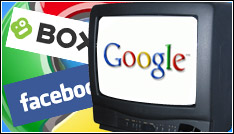New Apple TV Contrasts To Google Approach

With Apple TV the company is aiming to shift users’ television habits, while Google wants to reinvent them
When Apple chief executive Steve Jobs unveiled the new Apple TV on 1 September in one of his patented oh-there’s-one-more-thing-moments, analysts rushed to compare the digital TV service to the forthcoming and ballyhooed Google TV.
The freshened Apple TV is like the old hobbyist passion, though streamlined and sans storage.
Where Apple once offered a $229 (£148) box for users to buy – another expensive piece of hardware – the company is now offering a quirky hockey puck of a device for $99.
Streaming machine
The device sports an HDMI connector, Ethernet and Wi-Fi, optical audio and USB plugs. There is no local storage.
The new Apple TV is like a streaming machine, offering high-definition movie rentals for $4.99 and a TV rental option for 99 cents per show. In the US, the popular Netflix streaming service is baked in, as is integration with YouTube, Flickr and MobileMe.
 Google TV, meanwhile, is an ambitious, sweeping effort to let users turn their televisions into computers.
Google TV, meanwhile, is an ambitious, sweeping effort to let users turn their televisions into computers.
Google TV attempts to marry channel surfing with web surfing. The service, scheduled for an autumn release, will let users navigate between all their channels and all their favorite websites and web applications through Google’s Chrome browser.
Google also has a Chrome webstore coming to sell applications such as games that users will be able to play on Google TV. Consumers will buy a set-top box to connect Google TV to their TV and a remote from Logitech to navigate the service.
Altimeter Group analyst Michael Gartenberg told eWEEK that while Google TV aims to be “input one” on user’s TVs, Apple TV is shooting to be “input two”.
In other words, where Google TV tries to supplant the cable box and fuse the TV content with its own web content, Apple TV aims to replace the DVD player. Both approaches face challenges.
Entrenched practices
Google TV is trying to shift decades of entrenched practice from cable TV providers. Apple TV is aiming to be another device users can connect to their TV to augment their viewing experience.
The irony of this proposition is that Jobs himself said in June that world doesn’t want another box. Now Apple has another box; it’s just one-quarter smaller.
Gartenberg gives the edge to Apple TV in potential to appeal to mainstream consumers.
“It’s going to be really hard to go after input No. 1,” Gartenberg said. “Going after input No. 1 on your TV is like going after the Russian front in the winter; it just doesn’t happen.”
“But Apple has a good shot at taking control of that second input, and more importantly to start teaching consumers to change and evolve their TV behaviour the same way they did with iPhones. Apple TV is to TV what iPhone was to phones, setting the stage for future products and services.
Of course, as Gartenberg pointed out in a blog post, Apple has no app store yet for Apple TV.
“While I think an app eco system for TVs can make sense, like the iPhone before it, Apple needs to educate the market on a paradigm shift. This Apple TV is a reset in many ways and the TV a device with very entrenched habits and behaviors. Before consumers can make a shift to that model, Apple needs to establish a position in the living room.”
Catching on
Another irony looms.
While Apple TV’s new form factor and price point plus Netflix integration may help the device shed that “hobby” tag its held since it launched in 2006, Google TV may find itself with that same designation.
Early reports are the TV service providers are reticent to support the service, whose ambitions are lofty. It’s quite possible Google TV may catch on only with Google fanboys; Apple TV is alive today thanks to the company’s fanatical fanboys.
Indeed, it’s possible Google TV becomes the next, “old” Apple TV. In any case, Google and Apple’s battle for position in consumers’ living rooms this Christmas season promises to be exciting.